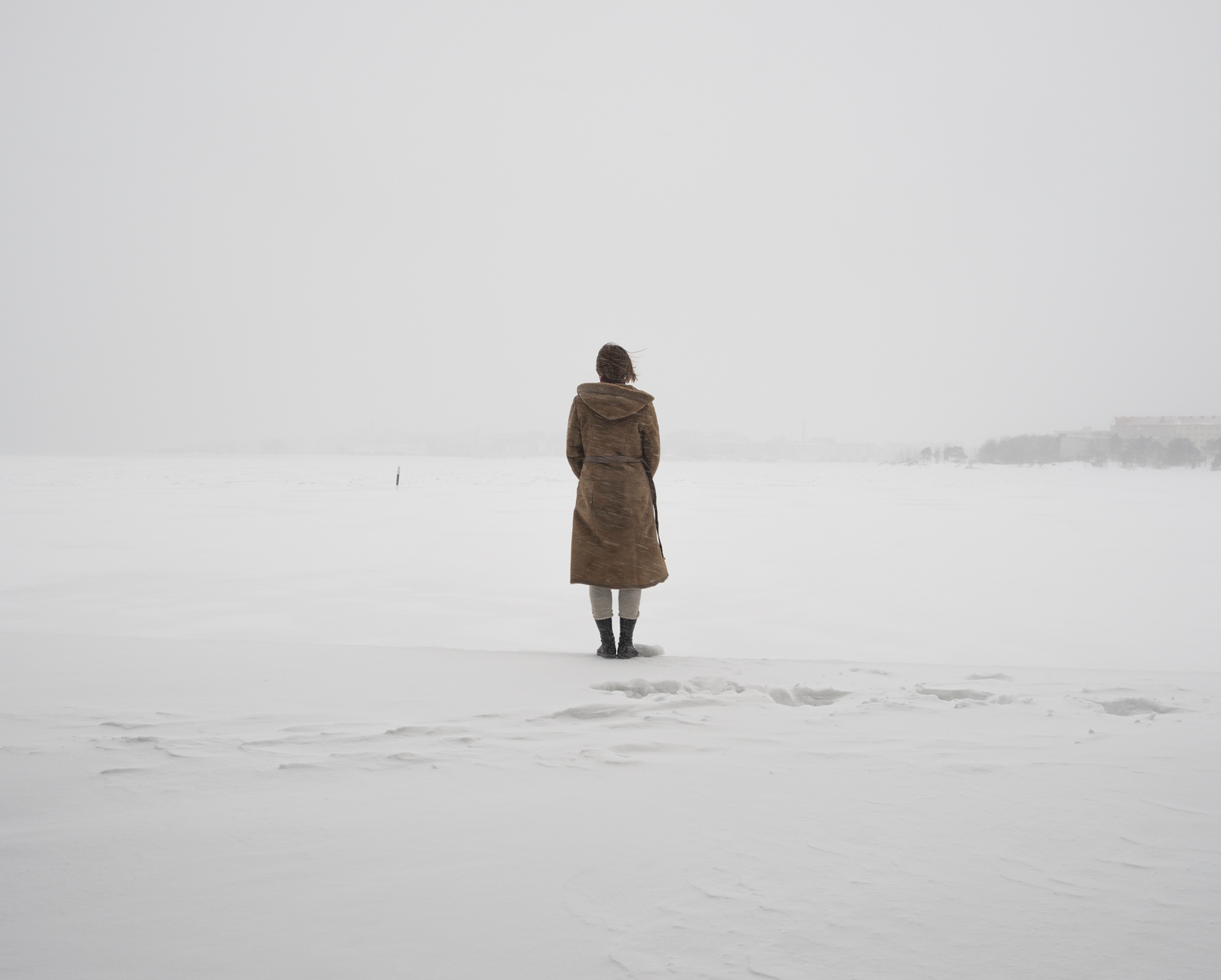The image above has knocked me for six, as has the whole of Elina Brotherus’s work Anonciation. The image, number 32 in the series, is the penultimate photograph of Anonciation. It is the frozen end point in her burning yearning to become a mother. It reduced me to tears.
“I’m showing this series of photographs to give visibility to those whose treatments lead nowhere,” says Brotherus. “The hopeless story with an unhappy end is the story of the majority.
“My way of discussing the matter is through pictures, not to give interviews. I’m not sure if I will ever be able to speak about this. I’m still too sad.”
The image itself is, in visual terms, relatively simple – the lone solitary figure facing the frozen, barren, near colourless landscape stretching out as far as we can see. The footprints in the near foreground continue on across the image left to right leaving her alone in her own promontory in the snow.
The power of the image lies in the journey we take with Brotherus to that point. Through the anguish of failed attempts at motherhood and the interior spaces of her longing.

The 32nd image resonates, to my mind, with Rachael Whiteread’s sculpture Ghost, which recreates a Victorian bedroom, replete with fireplace, from a negative space.
As Carol Mavor notes in Reading Boyishly: “Whiteread’s Ghost stands in frozen white tundra.”
Or, as Arthur Danto observed: “The room was in effect turned inside out. That and its funerary witness make it a monument to lost childhood.”
Or, in Brotherus’s work, lost motherhood. The interior domestic spaces of Anonciation are utterly compelling. Her negative space is visual concrete, locking her in. Psychologically, the walls are closing in around her. We can viscerally feel the same stillness of the tundra moving into her home, a place that should be filled with a childhood of her creation. Brotherus is revealing to us, so, so painfully, the most primal of depressions.
And I think it is here in the lost motherhood: lost childhood relationship that I find myself so struck with Brotherus’ image (and rest of work). In my own work I continue to grapple with maternal abandonment, and that terrifying internal chasm it creates. Part of me feels lost and invisible on the other side of Brotherus’ tundra (or behind her, of course, as the viewer), the unwanted child staring back at the desperate, would-love-to-be-mother.
The wanting mother – the unwanted child. She, a mother without a child. Me, a child without a wanting mother.
It takes me back to the moment I tried to explain to a tutor why the negative space around this image of my baby tag was so important. ‘After’, my last project, was all about loss: of mother, of anchors, of umbilical cords.

The image was never really about the tag, or the fact it was broken, or the proof that I existed. It was, and Brotherus has given me the confidence to say this now, about the empty space around it, the soft pink tundra, seemingly maternal and warm, but heartbreakingly empty.
Exactly where this love of Brotherus’s work leaves me in my current project (working title ‘Trees and Meadows’), I’m not yet sure.
I’m captivated by the visual unfolding of Brotherus’ work and how she puts herself so vulnerably into the frame. I am making a similar attempt to put myself into the frame. But whereas Brotherus’ work tells the story of lost motherhood as an evolving story, my own performative project is one of retraced memory.
At its heart I seek to understand why my son is like a tree, so solid in his sense of self, growing branches from a sturdy base, and why I am a meadow, where seeds seem to fall, grow for a season and then die as they are replaced by some other plant, of course shoots from an exploration of the differences between the wanted (Tom) and unwanted child (me).
Much of the work so far is set in our real domestic environment. I have given up a good deal of control. The performances are the result of a game with my children (who chose the character/task combination) and the images are being taken by my daughter. I am consciously rendering myself partly impotent in the image making, and subjecting myself to the whims of play and the decisions of another, or simply chance.
There is, I hope, some interesting exploration to be done in terms of Tom’s and my relationships to the domestic environments that envelope us (for him truly a home, for me, the space within which I currently reside), and the very dear bonds that connect us. When I get further along, I will return to Brotherus again and again, and reconsider what her domestic and external settings tell me about my own.
References:
Elina Brotherus. (n.d.). Annonciation (2009-2013). [online] Available at: http://www.elinabrotherus.com/annonciation/164pxrdop7bn456ebbf3tpk8y8rduj [Accessed 26 Oct. 2020].
Bright, S., Antoni, J. and The Photographers’ Gallery (2013). Home truths : photography and motherhood. London: Art Books.
www.nga.gov. (n.d.). Ghost. [online] Available at: https://www.nga.gov/collection/art-object-page.131285.html.
Mavor, C. (2007). Reading Boyishly : Roland Barthes, J.M. Barrie, Jacques Henri Lartigue, Marcel Proust, and D.W. Winnicott. Durham, N.J.: Duke University Press.





2 thoughts on “ Elina Brotherus: “The Hopeless Story with an Unhappy End” ”